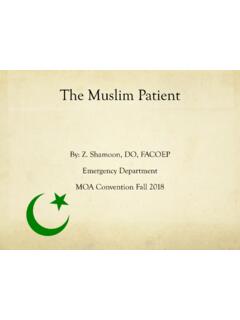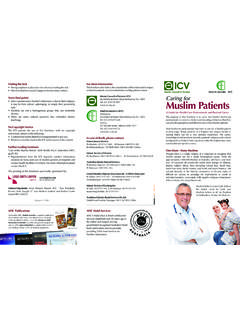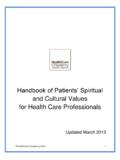Transcription of Online Journal of Cultural Competence in Nursing and ...
1 Culture Care of Syrian Muslims 1. Online Journal of Cultural Competence in Nursing and Healthcare Volume 1 No. 3 (2011). The use of Culture Care Theory with Syrian Muslims in the Mid-western United States Wehbe-Alamah, H. (2011). The use of Culture Care Theory with Syrian Muslims in the Mid- western United States. Online Journal of Cultural Competence in Nursing and Health- care, 1(3), 1-12. 2011 The Author. Reprints and permissions: ABSTRACT practices related to health and illness of Syr- Purpose: To discover, describe and ian Muslims will assist US nurses and other analyze the traditional generic (lay, folk, in- health care professionals to provide this group digenous) and professional care meanings, with culturally meaningful care and lessen beliefs, and practices related to health and ill- Cultural pain, clashes, imposition, and con- ness of traditional Syrian Muslims in the Mid- flicts. western United States (US). Clinical Relevance: Nurses are in- Design and Research Methods: Lein- creasingly caring for patients from cultures inger's Culture Care Theory and ethnonursing other than their own due to increased immi- research method were used for this study.
2 Re- gration and diversity within the US. Findings search participants included 10 key and 20 from this study may be used by US health general informants who ranged between the care providers such as registered nurses, nurse ages of 18 to 79 years. practitioners, and others to provide traditional Findings: Three themes were discov- Syrian Muslims with culturally congruent and ered: Traditional Syrian Muslim men and holistic care. women share caregiving responsibilities and practices to promote healthy family and com- munity lifeways; traditional Syrian Muslims Key Words: Syrian, Muslims, culture care, view caring for family members, friends, all ethnonursing, Leininger's theory, culturally living creatures, and oneself as embedded in c o n g r u e n t c a r e . religion; and, traditional Syrian Muslims rely on Islamic spiritual care to promote health The Syrian Arab Republic lies at the and prevent illness. Eastern end of the Mediterranean sea, and is Conclusion: Providing culturally con- bordered to the North by Turkey, to the East gruent care is a goal all nurses share or should by Iraq, to the South by Jordan, to the South- share.
3 Learning about the generic (lay, folk, west by Israel, and to the West by Lebanon or indigenous) care beliefs, expressions, and and the Mediterranean Sea (Bateman, 2002). Online Journal of Cultural Competence in Nursing and Healthcare Vol. 1, No. 3, 2011. Culture Care of Syrian Muslims 2. Present day Syria was once part of a land assist nurses and other health care profession- called Greater Syria, which encompassed Jor- als in providing them with culturally congru- dan, Lebanon, and Israel in addition to mod- ent care. ern Syria (South, 1995). After receiving their independence from the French mandate, peo- Purpose, Goal, and Domain of Inquiry ple from the regions of Syria and Lebanon The domain of inquiry for this ethnon- immigrating to the US continued to identify ursing study was the generic and the profes- themselves as Syrians until the 1950's. The sional care meanings, beliefs and practices initial impetus for Syrian immigration was the related to health and illness of Syrian Mus- lure of economic opportunity in the US.
4 By lims living in several urban communities in 1940, 350,000 persons of Syrian/Lebanese the Midwestern United States. The purpose of birth were living in the US (Hasser Bennett, this study was to discover, describe and ana- 2000). According to the 2004 US Census Bu- lyze the influences of worldview, Cultural reau Report, the number of people who context, technological, religious, political, marked their ethnic origin as "Syrian" on the educational, and economic factors on the tra- Census survey in 2000 was 142, 897. This ditional Syrian Muslims' generic and profes- figure does not accurately reflect the Syrians sional care meanings, beliefs, and practices. living in the US as it does not take into ac- The goal of this study was to provide the count Syrians identifying themselves as nurses with knowledge that can be turned into White or Asian (US Census Bureau, care actions and decisions that facilitate the 2004). Data from the 2010 US census for esti- provision of culturally congruent care to Syr- mated number of Syrians in the US could not ian Muslims living in urban communities in be located.
5 The Midwestern United States. It is estimated that more than 80% of Syrians are Muslims. Christians account for BACKGROUND. 10% of the population and include Syrian Or- In preparation for this study, the re- thodox, Greek Orthodox, Armenian Ortho- searcher conducted a comprehensive search in dox, as well as a few Roman Catholics, Prot- the literature regarding the domain of inquiry, estants, and Russian Orthodox. An offshoot involving search engines such as CINAHL, group of Islam known as the Druze accounts Medline, Google, ArticleFirst, ERIC, First- for 3% of the population. There are also small Search, Proquest, and PubMed, and discov- groups of Jews and Yazidis, a sect that com- ered that studies conducted in the US, solely bines aspects of Judaism, Christianity, and with the Syrian population, were practically Islam (South, 1995). nonexistent. However, the author did find a Dr. Madeleine Leininger, who devel- few studies conducted in the US with several oped the Culture Care Theory and ethnon- Arab cultures, including Syrian (Hammad, &.)
6 Ursing qualitative research method used in Kysia, 1996; Kulwicki, & Cass, 1994; Rice, this study, contended that by the year 2020, & Kulwicki, 1992) as well as a plethora of healthcare worldwide will be based on studies conducted in Syria to investigate nu- transcultural principles in order to appropri- merous medical problems, physical abuse and ately serve the needs of diverse people mental disorders (Alkhatib, Gilthorpe, &. (Leininger & McFarland, 2002). Learning McGrath, 2002; Dashdash, 2000; Haidar, about the generic (lay, folk, or indigenous) 2002; Othman, & Monem, 2001; Maziak, &. and professional care meanings, beliefs and Asfar, 2003; Maziak, Fouad et al., 2004; and practices related to health and illness of tradi- Maziak, Hammal et al., 2004). The synthesis tional Syrian Muslims living in the US will of the literature review revealed a prevalence Online Journal of Cultural Competence in Nursing and Healthcare Vol. 1, No.
7 3, 2011. Culture Care of Syrian Muslims 3. of oral health and smoking problems, neo- (Leininger, & McFarland, 2002). When cul- plastic diseases, hepatic problems, Cutaneous tural care values, beliefs, expressions, and Leishmaniasis, and Beta-thalassemia muta- practices of people of diverse or similar cul- tions, as well as physical abuse and mental tures are discovered and used in appropriate, distress involving low-income Syrian women. sensitive, and meaningful ways, culturally However, it also identified a dearth of studies congruent and therapeutic care occurs conducted in the US with Syrian Muslims as (Leininger, & McFarland, 2006). the primary research participants and identi- fied a lack of information in relation to the Ethnonursing Research Method generic as well as professional care beliefs, Leininger's qualitative ethnonursing attitudes, and practices of this population. research method was ideal for this study since it fit well with the Culture Care Theory and THEORETICAL FRAMEWORK with the goal and purpose of this study.
8 Eth- The theoretical framework for this nonursing research is an open discovery and study was Leininger's theory of Culture Care naturalistic people-centered research method Diversity and Universality which holds care developed by Leininger with the goal of teas- as the essence and unifying focus of Nursing ing out complex and largely unknown peo- (Leininger, 1991). According to the Culture ple's emic (local) viewpoints about Nursing Care Theory, care is embedded in people's dimensions such as human care, wellbeing, social structure, worldview, language, and health, and environmental influencers environmental context (Leininger, & (Leininger, & McFarland, 2006). Leininger McFarland, 2006). Cultural diversities and (1991) stated that a major reason for estab- universalities about human care exist among lishing this method was her interest in discov- and within all cultures worldwide, and dis- ering the differences and similarities of ge- covering knowledge of them can be used to neric care and professional Nursing care guide Nursing care decisions and actions among different cultures.
9 Which will be beneficial to clients' health This study took place in several urban INFORMANT'S AGE GENDER PLACE OF YEARS IN THE. CODENAME BIRTH US. K01 46 Male Syria 23. K02 46 Female Syria 30. K03 46 Male Syria 13. K04 36 Female Syria 13. K05 65 Male Syria 35. K06 38 Female Saudi Arabia 16. K07 48 Female Syria 31. K08 42 Female Syria 15. K09 27 Male Syria 6. K10 28 Female Syria 9. Table 1: Demographic characteristics of key informants Online Journal of Cultural Competence in Nursing and Healthcare Vol. 1, No. 3, 2011. Culture Care of Syrian Muslims 4. Midwestern communities over the period of in the United States to Syrian parents; cur- two years in places identified as comfortable rently living in the US; stated Cultural identity by informants, such as homes, mosques, of- as Syrian Muslim; knowledgeable about the fices, Middle Eastern restaurants and other domain of inquiry; and willing to participate places of the informants' choosing.
10 Ten key in the study. Key informants were considered informants (Table 1) and 20 general infor- to be more knowledgeable than general infor- mants (Table 2) were interviewed for this mants about the domain under study and were study. Informants were recruited using the interviewed on two different occasions. The snowball method as long as they met the fol- interviews, which lasted anywhere from 45. lowing recruitment criteria: 18 years of age or minutes to hours, consisted of asking semi older; born to Syrian parents in any country in -structured questions derived from Lein- the world and then moved to the US or born inger's Open-ended Inquiry Guide. Consent INFORMANT'S AGE GENDER PLACE OF YEARS IN. CODENAME BIRTH THE US. G01 32 Female Syria 15. G02 38 Female Syria 22. G03 49 Female Syria 29. G04 42 Female Syria 12. G05 30 Male Midwestern US 30. G06 29 Female Syria 9. G07 33 Female Syria 10. G08 25 Female Syria 7. G09 32 Female Syria 13.









